Nucleus helps the beekeeper to obtain and fertilize young queens using a simplified system. The design device resembles a beehive, but there are some nuances. Nuclei are large and miniature – micronuclei. A beekeeper must have good experience in order to be able to form a family and breed a queen.
What is a nucleus
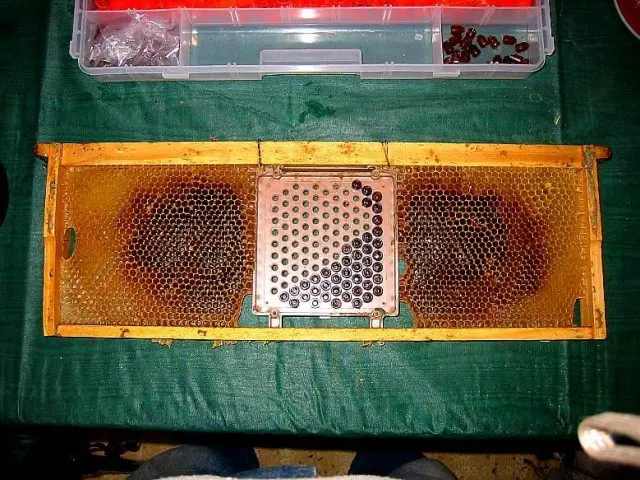
In fact, the nucleus is a reduced size of the hive. In Latin, it means core. For beekeepers, the term means the basis of the bee colony. The small size of the body does not allow to accommodate many insects. An understaffed colony consists of a maximum of 1000 strong worker bees and a queen. Compared to the micronucleus, the nucleus is larger and may contain several queens.
Inside, the nucleus is like an ordinary hive with a full-fledged family. However, due to the smaller number of worker bees, they are not able to provide themselves with food for the winter. A small family cannot resist the attack of other full-fledged bee colonies. Knowing their weakness, the bees begin to develop faster. This is the plus of the nuclei.
There are three varieties:
- micronuclei;
- medium size;
- large nuclei.
The main difference is in size. Large cores can be used in place of regular hives. Their disadvantage is the need to populate a large number of bees.
In beekeeping, nuclei are needed to fly around the queens, or more precisely, for two purposes: fertilization and breeding of new queens. It is unprofitable to work with queens in hives. It will take a lot of drones that are not useful in the apiary. It is more profitable to acquire several cores.
Another purpose is family reproduction. In small enclosures, bees develop faster. The family grows independently without the constant supervision of a beekeeper.
What is a micronucleus
In continuation of the deciphering of the terms, it should be noted that the micronucleus is the same design, only reduced in size. The translation of the word nucleus is similarly preserved – the core. The term micro means small. Together, a small bee colony is obtained.
Large cores are less popular with beekeepers. Most often, mini-nucleuses are bought for the apiary because of the ease of maintenance and low cost. The price of one micronucleus is within 700 rubles.
Polystyrene is often used to make the case. Inside, 4 frames and a feeder are installed. Polish models are popular, equipped with a lower entrance, which excludes the theft of honey by other bees. Compared to a large nucleus, a micronucleus is calculated for one uterus. The advantage is the need to populate a small number of bees. However, there are drawbacks. Due to the small size of the frames, the uterus quickly sows them. If the queen is not taken out of the micronucleus in time, she will fly away a few days after fertilization.
What materials is it made from
The bee nucleus is made from the same materials as the hives themselves. Traditionally there is a tree: pine, spruce. For home-made structures, fiberboard is used. Modern models are made of polystyrene foam, polyurethane foam, polystyrene foam. The main requirement for the material is environmental friendliness.
Which nucleus is better for bees
The beekeeper chooses the optimally suitable micronucleus model for himself. Often Dadan, containing 12 frames, is divided into 6 buildings. However, a single design containing 3 frames is considered the best.
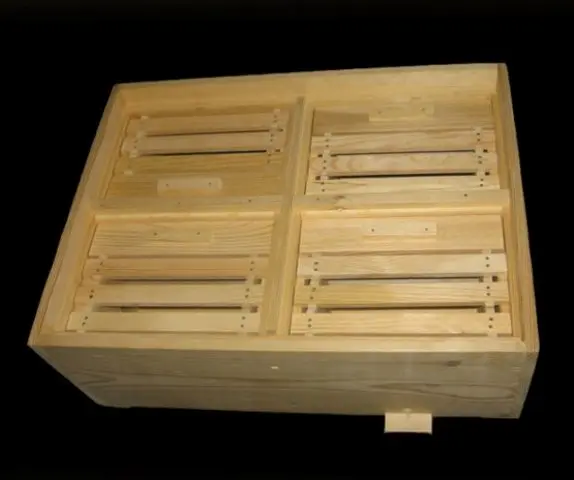
A core is considered economical, with a divided body in four compartments, each of which accommodates 3 small frames 100×110 mm in size.
There are corner models. Frames are not used in such micronuclei. The walls are made with bevels. Foundation is installed in the grooves.

A single micronucleus has a feeder at the top. The letok is equipped with a regulator. Often angled micronuclei are made from PPU, PPS, or foam. There are wooden structures.
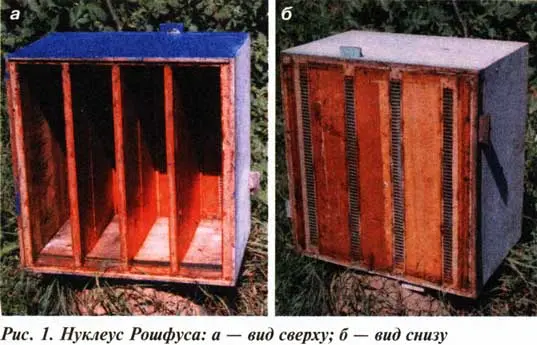
Rochefus cores are popular with amateur beekeepers. The design consists of a wooden case with a bottom. Deaf partitions divide the interior space into compartments. Usually there are 4 of them. The bottom of each compartment has a slot closed with a grate. Through it, the bees make their way to the main family, but do not contact the queen. From above, each compartment is closed with a lid or feeder, there is an individual notch. To make the house recognizable by bees, its walls are painted with four different colors.
The video tells more about the best models:
How to make a bee nuc
The easiest way is to make do-it-yourself cores from PPU or PPS, but wood will do. If there is no experience, you will need a drawing. Schemes can be found in specialized literature, the Internet. The need for a drawing is explained by the presence of the dimensions of each element. For example, a micronucleus is often made in standard dimensions: 175x76x298 mm. The dimensions of the core for a full polyurethane foam frame are: 315x405x600 mm. The sequence of numbers indicates the height, width and length, respectively.
However, these dimensions are not required. These are just examples. Each beekeeper collects micronuclei and large bodies according to his measurements.
Do-it-yourself nuclei for bees: drawings, materials, tools
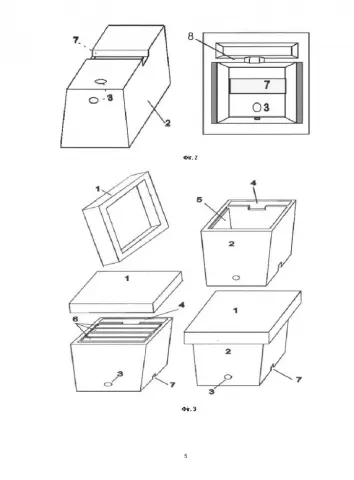
Most of the do-it-yourself drawings for making nuclei for bees show the elements of the body and the internal structure. Dimensions on the diagrams may not be indicated. It is important for a beekeeper to know the basic components. The size is calculated individually.
A set of tools for work depends on the selected material. To process wood, you will need a saw, a jigsaw, sandpaper. PPS, PPU and polystyrene are easily cut with a knife.
Assembly process
The sequence of assembling the core with your own hands consists of the following steps:
- On the material selected for manufacturing, markup is applied according to the drawing.
- The body is assembled from the cut fragments. PPS, polystyrene or polyurethane foam are glued together, reinforced with self-tapping screws. Fragments of a wooden case are knocked down with nails.
- The internal space of the body is divided by partitions of the same size. They are attached to the side walls of the box with self-tapping screws.
- Inside the box, fasteners are equipped for frames, a feeder. Making a lid. Tapholes are cut out for each compartment. The maximum hole diameter is 15 mm.
- The bottom of the micronucleus or large body is equipped with legs from the outside. Usually, coasters are made of 4 bars, screwing them to the body with self-tapping screws.
The finished structure is tested for strength. In the final, the body is painted.
How to make frames for the nucleus

Frame sizes are as follows:
- 145×233 mm – 1/3 Route;
- 145×145 mm – 1/3 Added;
- 206×134 mm – ¼ lounger.
In non-standard home-made micronuclei, the size of the frames is calculated individually. They must fit inside the case.
A design feature of the core frame is its dimensions. It is half the standard frame. If they need to be installed in an ordinary hive, the frames are connected with a nail or a piano loop.
Frames are made from slats. For mass production, it is desirable to have a special template – a jig. Reiki are fastened together with nails.
Rules for working with the nucleus
Working with a nucleus or micronucleus has its own characteristics that differ from the maintenance of hives.
How to properly form a bee colony in the nucleus

In order for the formation of micronucleuses or large analogues to be successful, a developed strong family of bees is chosen during honey collection or swarming. The procedure is performed before lunch. At this time, the hives are almost empty. Inside there are bees-breadwinners, guards and new brood.
The order of formation of a family of bees depends on the weather:
- In the southern regions, beekeepers install two fodder frames with honey and one with brood in the nucleus. Additionally, about 300 worker bees are laid.
- In cold regions, the same number of frames with food and brood are placed in the nucleus. Usually two pieces. The number of worker bees is increased to 600 individuals.
The brood for the formation of a family of bees is taken sealed. The amount of feed is at least 2 kg. A maturing mother liquor is placed inside a large body or micronucleus. If the queen is not fertilized, she is isolated in a cage, and released after 5 days.
In place of the taken brood and food, a void is formed inside the main hive. It is filled with honeycombs with wax. A complete micronucleus or a large body is insulated. The letok is reduced to the size of a bee so that only one individual crawls through the hole. The letok is expanded with the beginning of mating of the uterus.
Over time, the young bees will leave the comb. The beekeeper removes the empty frames and replaces them with new ones with larvae. The replacement procedure allows you to load the young with work. Everything must be done before the start of the laying of the queen.
How to breed queens
Each beekeeper has his own secrets for breeding queens in micronuclei. The procedure for the Rochefus model consists of the following steps:
- After completing work with the family of bees, the teacher removes the upper case from the hive. Frames with bees are transferred to the lower building, where there is a queen. The old uterus is allowed to be culled, and the young one is transferred to another nucleus. At the time of the procedure, it should be inhabited by a strong colony of foreign bees.
- From the family of bees left without a queen, frames with printed brood and offended bees are taken. They are transferred 1 piece to each Rochefus compartment. Supplement 1 feed frame. A mature mother liquor is added to the brood frames. The completed nucleus is returned to the body of the hive with the main family of bees.Important! At the time of installation of Rochefus, there should be no fetal queen in the main body of the hive. Otherwise, new queens will be destroyed.
- After a period of time, a queen will appear inside each compartment and fly out through an individual notch to mate with the drones.
The technology allows you to get at least 4 fetal queens from one family of bees. In warm weather, you can further increase the yield of queens by placing an additional Rochefus on top.
How to save the nucleus in winter
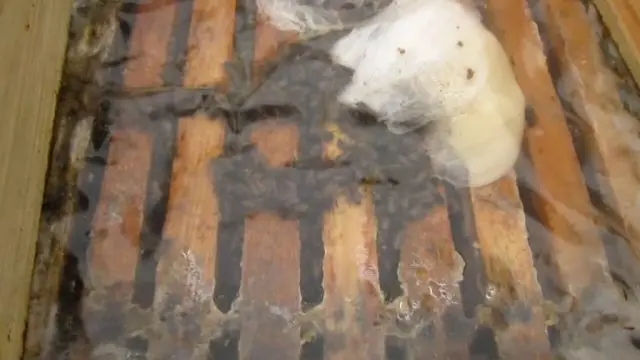
In order for the wintering of nuclei and weak bee colonies to be successful, the beekeeper is preparing. Optimally, to obtain a developed family of bees, the queen should be added no later than July 25th. Sowing will go from this queen.
Due to bad weather conditions or if it is impossible to take out the apiary, the honey collection ends ahead of schedule. Bees need to be fed with syrup in the amount of 250 to 350 g per nucleus. For 1 or 2 days, about 2 liters of syrup are fed.
For wintering, each family of bees is provided with 4 half-frames filled with honey. With the onset of cold weather, the cores are brought into the omshanik, placed on top of the hives. On the upper tier, the bees will be warmer.
Conclusion
Nucleus is a convenient invention and is available to every experienced beekeeper. The beekeeper has the opportunity to independently breed queens, increase families without buying bee packages.









